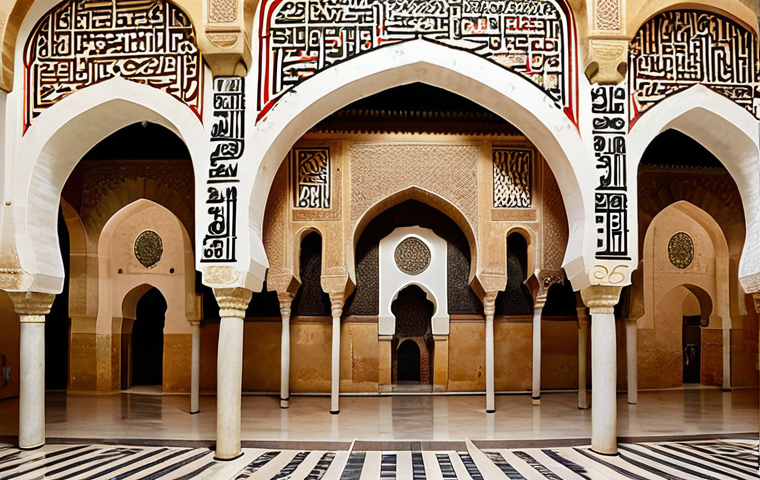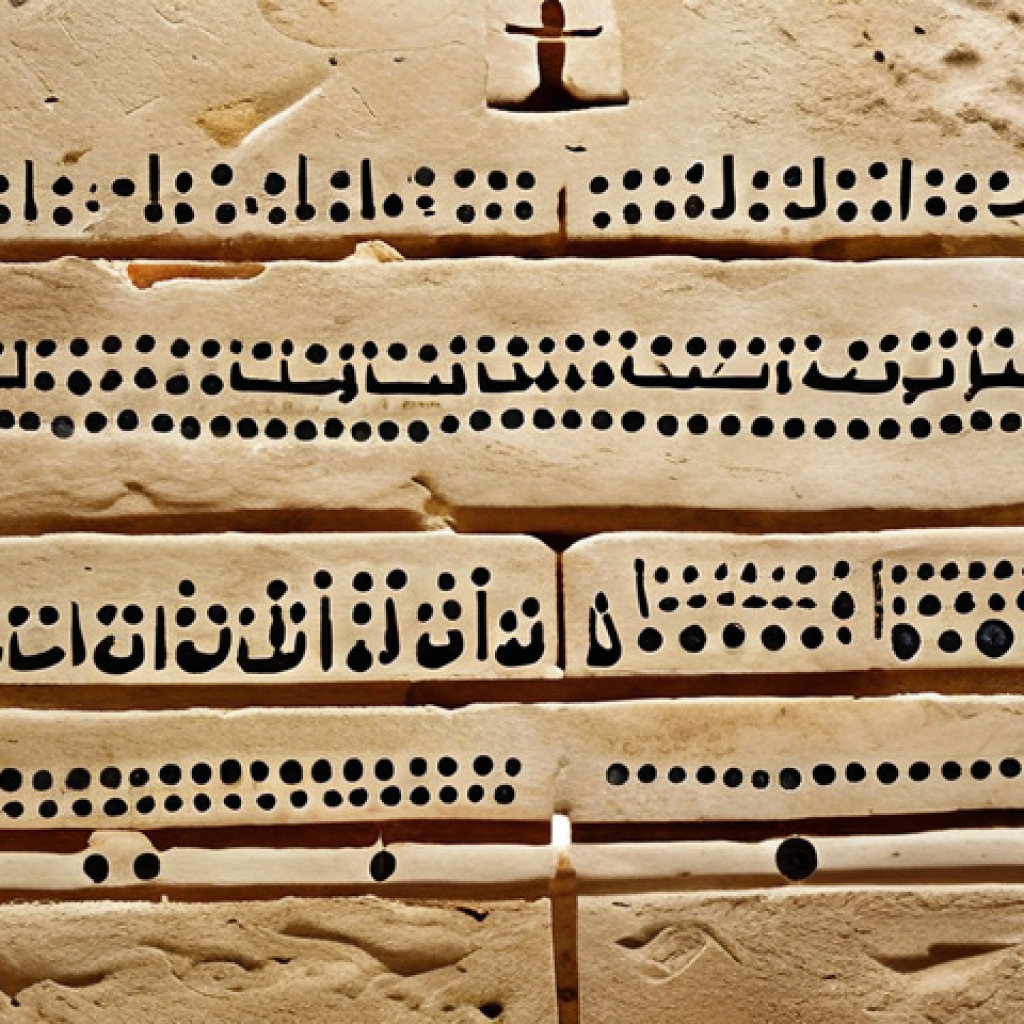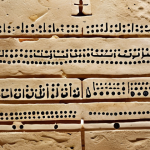From ancient inscriptions etched in stone to the flowing calligraphy of modern times, the Arabic script has undergone a fascinating evolution. Imagine the early traders and scholars, adapting symbols to capture the nuances of their spoken language, laying the foundation for a writing system that would spread across continents and cultures.
It’s a story of innovation, adaptation, and the enduring power of language. And, like any living thing, the Arabic alphabet continues to evolve, influenced by technology and global communication.
Prepare to delve into its rich history and discover how this beautiful script has transformed over the centuries. Let’s explore the specifics in the text below!
The Genesis of a Script: Early Forms and Influences

Adapting Symbols for Sound
The earliest forms of the Arabic script weren’t quite what we recognize today. Imagine a simpler, less refined set of symbols, borrowed and adapted from the Nabataean alphabet.
These weren’t just random scribbles; they were carefully chosen and modified to represent the specific sounds of the Arabic language. It’s kind of like how you might tweak an existing recipe to make your own signature dish.
The early adopters experimented, adding dots and strokes to distinguish between similar-sounding letters, slowly but surely building a more comprehensive system.
I remember seeing some of these early inscriptions in a museum once, and it struck me how much ingenuity and effort went into creating something so fundamental to communication.
The Northern vs. Southern Debate
Interestingly, there’s been some debate among scholars about the exact origins of the script. Some believe it evolved primarily in the north, while others argue for a more significant southern influence.
The truth probably lies somewhere in between. Different regions likely contributed to its development, each adding their own unique flavor to the mix.
It’s like the different regional variations in barbecue sauce across the US – each has its own distinct character, but they all share a common ancestor.
Ultimately, this regional diversity enriched the Arabic script, making it a versatile tool for expressing a wide range of dialects and accents.
Kufic Calligraphy: A Monumental Milestone
From Practicality to Art Form
As the Arabic script became more established, it began to evolve from a purely practical tool for recording information into an art form in its own right.
Kufic, with its bold, angular lines and geometric precision, emerged as a dominant style. Think of it as the architectural blueprint of the script world – strong, stable, and visually striking.
Adorning Mosques and Manuscripts
Kufic wasn’t just pretty to look at; it was used to adorn mosques, palaces, and important manuscripts. You’d see it carved into stone, woven into textiles, and painted onto pottery.
I recall visiting the Great Mosque of Cordoba and being mesmerized by the Kufic inscriptions that lined the walls. They weren’t just decorations; they were powerful statements of faith and culture.
The intricate patterns and rhythmic repetition of the letters created a sense of awe and reverence.
The Rise of Naskh: A Script for the Masses
Streamlining for Speed and Readability
While Kufic was grand and imposing, it wasn’t always the most practical script for everyday use. Enter Naskh, a cursive style that prioritized speed and readability.
Imagine trying to write a long letter in Kufic – your hand would probably cramp up halfway through! Naskh was designed to be more fluid and efficient, making it ideal for writing books, letters, and other documents.
I remember learning calligraphy as a kid, and Naskh was one of the first styles I tackled. It felt so much more natural and flowing compared to the rigid forms of Kufic.
The Standard Script of the Islamic World
Naskh quickly became the standard script of the Islamic world, used in everything from religious texts to scientific treatises. It’s like the switch from typewriters to computers – Naskh revolutionized the way people wrote and communicated.
Its influence can still be seen today in many modern Arabic fonts and handwriting styles.
The Enduring Legacy of Diwani and Thuluth
Diwani: The Script of the Ottoman Court
Diwani, with its elegant curves and ornate flourishes, emerged as the official script of the Ottoman court. It was used for royal decrees, official correspondence, and other important documents.
Think of it as the script equivalent of a finely tailored suit – sophisticated, stylish, and reserved for special occasions. The letters in Diwani often overlap and intertwine, creating a visually stunning effect.
It takes a skilled calligrapher to master this script, as the spacing and proportions are crucial to its beauty.
Thuluth: A Majestic Script for Sacred Texts
Thuluth is another highly esteemed script, often used for writing Qur’anic verses and other sacred texts. It is known for its bold, majestic forms and its ability to convey a sense of grandeur and reverence.
I’ve often seen Thuluth used in mosque decorations, its sweeping lines and intricate details adding to the spiritual atmosphere. Thuluth is considered one of the most challenging scripts to master, requiring years of dedicated practice.
Modern Adaptations and Digital Innovations
The Influence of Printing and Typography
The invention of printing and the rise of digital typography have had a profound impact on the Arabic script. New fonts and styles have emerged, adapting the traditional forms to the demands of modern technology.
Think about all the different fonts you have on your computer – each one is a unique interpretation of the basic alphabet. Similarly, Arabic typography has embraced a wide range of styles, from classic revivals to contemporary designs.
Arabic Script in the Digital Age
Today, the Arabic script is thriving in the digital age. It’s used on websites, social media, and countless other platforms. There are even specialized keyboards and software programs designed to make it easier to type in Arabic.
I remember when I first started using Arabic online, it was a bit clunky and difficult. But now, there are so many great tools available that it’s become much more accessible.
The Arabic script has proven its ability to adapt and evolve, ensuring its continued relevance in the 21st century.
Calligraphy as Contemporary Art
Transcending Traditional Boundaries
Arabic calligraphy is no longer confined to traditional religious or ceremonial contexts. Contemporary artists are pushing the boundaries of the art form, incorporating it into paintings, sculptures, and installations.
I’ve seen some amazing examples of this in galleries around the world. Artists are using calligraphy to express a wide range of emotions and ideas, from political commentary to personal reflections.
A Fusion of Tradition and Innovation
These artists are not just copying the old masters; they are creating something new and original. They are blending traditional techniques with modern materials and concepts, resulting in a vibrant and dynamic art scene.
It’s like a chef taking a classic recipe and adding their own unique twist. The result is something that is both familiar and surprising. Here’s a table summarizing the evolution of Arabic script styles:
| Script Style | Characteristics | Common Uses | Approximate Period |
|---|---|---|---|
| Nabataean | Early, less refined forms | Inscriptions, early documents | Pre-Islamic Era |
| Kufic | Bold, angular, geometric | Mosque decorations, monumental inscriptions | 7th-13th Centuries |
| Naskh | Cursive, legible, streamlined | Books, letters, official documents | 10th Century Onward |
| Diwani | Ornate, curved, complex | Ottoman court documents | 16th Century Onward |
| Thuluth | Majestic, bold, decorative | Qur’anic verses, religious inscriptions | 11th Century Onward |
| Modern Typography | Adaptations for printing and digital media | Books, websites, digital documents | 20th Century Onward |
The Global Impact of Arabic Script
Spreading Across Continents and Cultures
The Arabic script has had a profound impact on cultures far beyond the Arab world. It’s been used to write numerous languages, including Persian, Urdu, and Malay.
Think about how the Roman alphabet has been adapted to write English, French, Spanish, and countless other languages. Similarly, the Arabic script has proven its versatility and adaptability, becoming a vital tool for communication across a vast geographical area.
A Shared Heritage
This widespread use of the Arabic script has created a shared cultural heritage that transcends national boundaries. People from different countries and backgrounds can recognize and appreciate the beauty and elegance of the script.
It’s a reminder of the interconnectedness of human cultures and the power of language to unite us. The beauty and historical significance continue to inspire and influence artists, designers, and scholars around the world.
The journey through the evolution of the Arabic script is a fascinating exploration of culture, art, and communication. From its humble beginnings as a modified alphabet to its current status as a global language tool, the Arabic script continues to captivate and inspire.
Whether you’re a seasoned calligrapher or simply curious about different writing systems, I hope this overview has provided some valuable insights into the rich history and enduring legacy of this remarkable script.
It’s a story written not just in ink, but in the very soul of civilizations.
In Closing
As we’ve seen, the Arabic script’s evolution is a testament to its adaptability and enduring beauty. From ancient inscriptions to modern digital fonts, it continues to bridge cultures and inspire artistic expression. I hope this journey through its history has sparked your curiosity and appreciation for this remarkable script.
Good to Know Info
1. Calligraphy workshops are a great way to learn the basics of Arabic script. Many community centers and art schools offer introductory classes.
2. There are numerous online resources for exploring Arabic calligraphy, including tutorials, font libraries, and historical archives. Check out websites like “Arabiс Typography” or “Islamic Arts Magazine” for inspiration and learning materials.
3. Museums with Islamic art collections often display examples of historical Arabic calligraphy. The Metropolitan Museum of Art in New York City and the British Museum in London have excellent collections.
4. If you’re traveling in the Middle East, be sure to look for local calligraphy artists and workshops. Many cities, like Dubai and Istanbul, have thriving calligraphy scenes.
5. For a unique gift, consider commissioning a calligraphic artwork with a personalized message. Many artists offer this service, and it’s a great way to celebrate a special occasion.
Key Takeaways
The Arabic script evolved from the Nabataean alphabet, adapting symbols for Arabic sounds.
Kufic was an early monumental style used for mosque decorations and important inscriptions.
Naskh became the standard cursive script for everyday writing and official documents.
Diwani, with its ornate curves, was the script of the Ottoman court.
Thuluth, known for its majestic forms, is often used for Qur’anic verses and religious texts.
Modern typography and digital innovations have transformed the Arabic script, ensuring its continued relevance in the digital age.
Frequently Asked Questions (FAQ) 📖
Q: What were some of the primary factors that influenced the evolution of the
A: rabic script from its earliest forms to its contemporary usage? A1: Well, from what I’ve read and understood over the years, several key factors played a significant role.
Think about the early days; the need to accurately represent the spoken language was paramount. This meant adapting existing symbols and creating new ones to capture the subtle nuances of Arabic.
Then you have the geographical spread, as trade routes and cultural exchange carried the script to different regions, resulting in regional variations and adaptations to suit local languages.
The advent of printing and, more recently, digital technology had a transformative impact. It pushed for standardization and made the script accessible on a global scale, shaping how we see and use it today.
I imagine it was quite a journey.
Q: Can you give examples of how
A: rabic script has been adapted and used differently across various cultures and regions, considering its wide geographical distribution? A2: Absolutely!
Having delved into this a bit, it’s fascinating how the script has been molded by different cultures. In Persian, for instance, while it uses the Arabic alphabet as a base, they’ve added letters to represent sounds unique to their language.
In Urdu, which is prevalent in Pakistan and India, you’ll find additional letters too, blending influences. Even in areas of Africa where Arabic became a language of scholarship, you see distinct calligraphic styles emerge, often influenced by local artistic traditions.
I recall seeing examples in museums, and the subtle differences in the curves and embellishments were just breathtaking. It’s like each region put its own unique stamp on the script.
Q: How has the advent of digital technology impacted the
A: rabic script, and what are some ongoing challenges and opportunities related to its representation and usage in the digital sphere? A3: Digital technology has been a game-changer, both good and, well, still evolving.
On the one hand, it has made Arabic script far more accessible globally. Think about smartphones and computers; now, people can easily type and share Arabic text regardless of location.
But, on the other hand, representing the script accurately in digital formats has presented challenges. Early character encoding standards sometimes struggled with the complexities of Arabic’s cursive nature and right-to-left writing direction.
Even now, there are ongoing efforts to ensure consistent rendering across different devices and platforms. But I see huge opportunities too. Digital tools are opening up new avenues for Arabic calligraphy and design, as well as for preserving and promoting the script’s rich cultural heritage.
I even tinkered with some online calligraphy tools myself; they’re pretty amazing!
📚 References
Wikipedia Encyclopedia
구글 검색 결과
구글 검색 결과
구글 검색 결과
구글 검색 결과
구글 검색 결과




